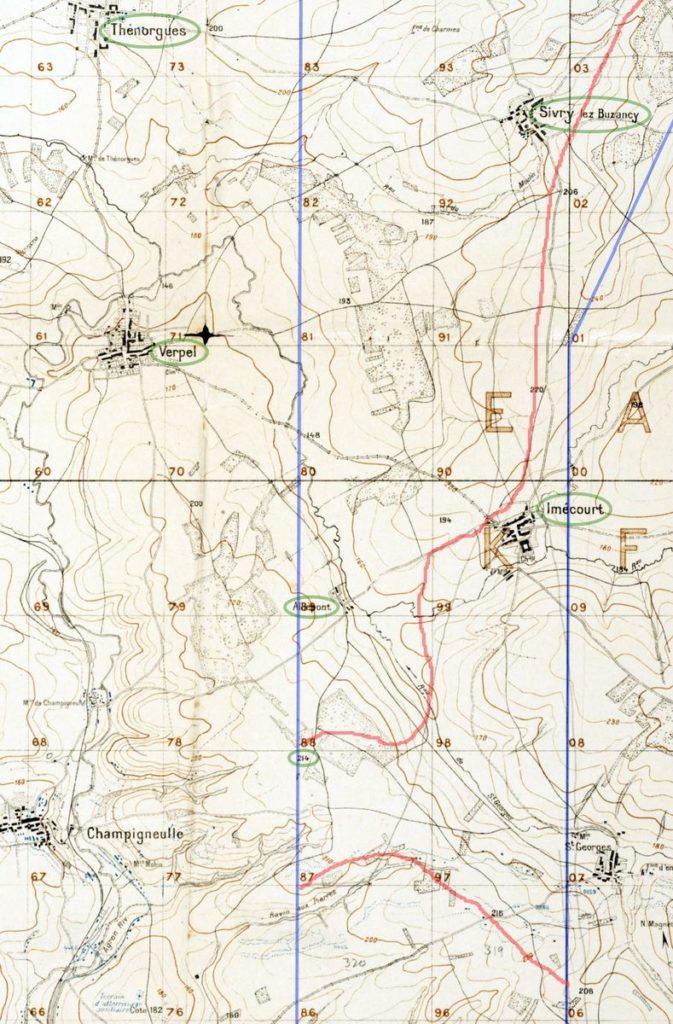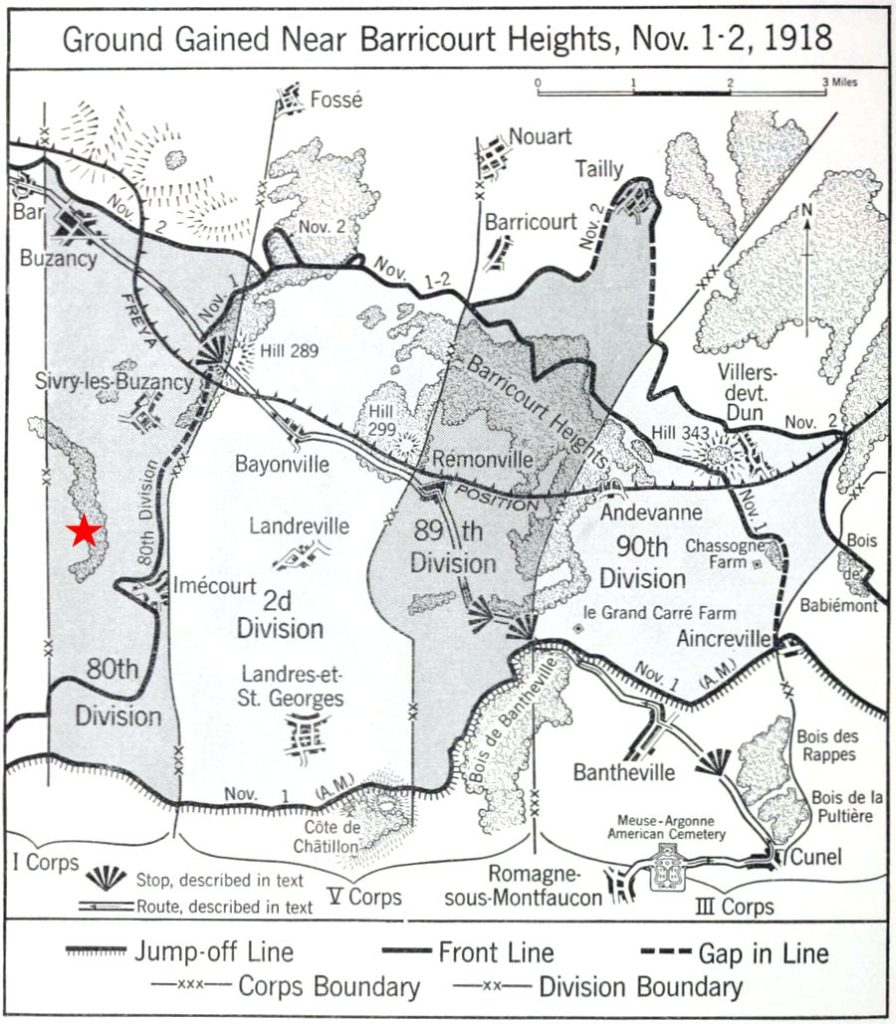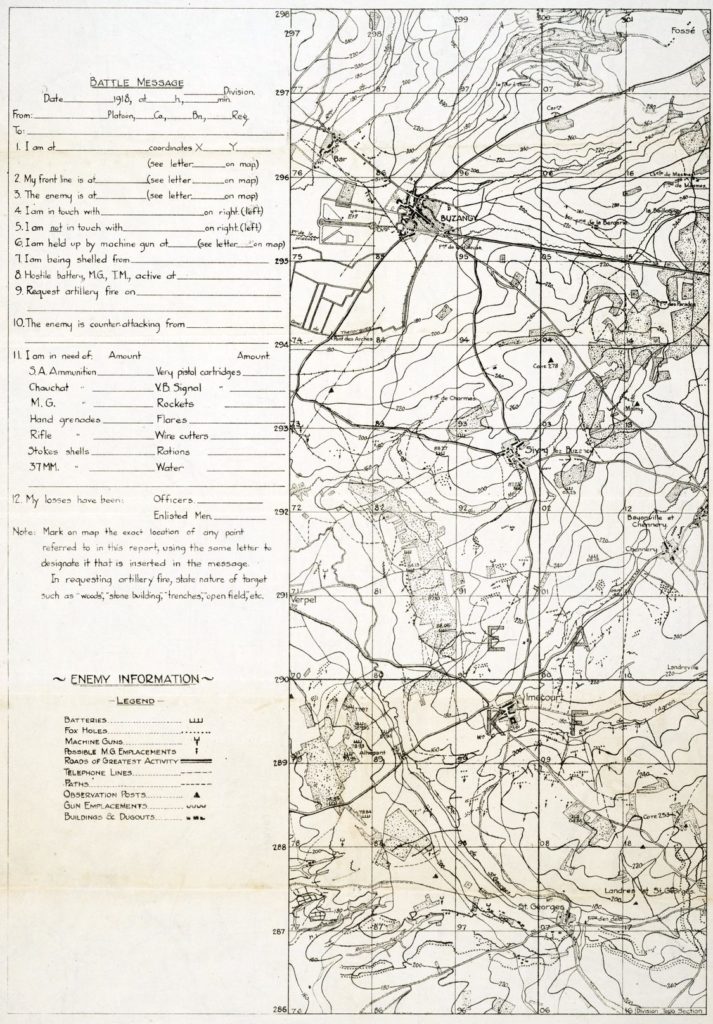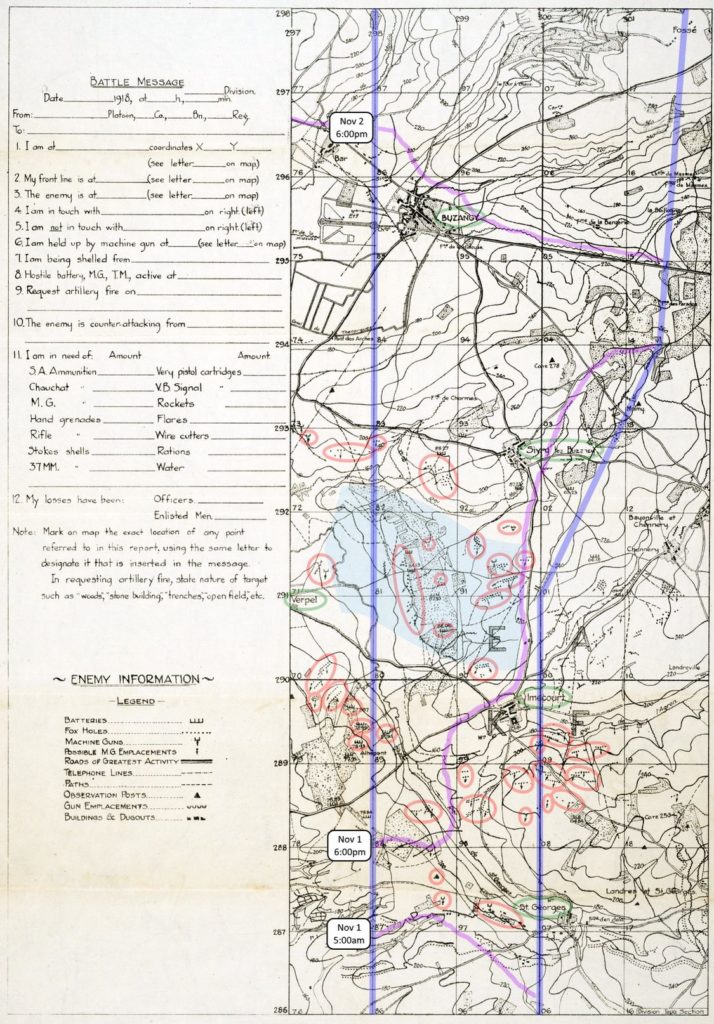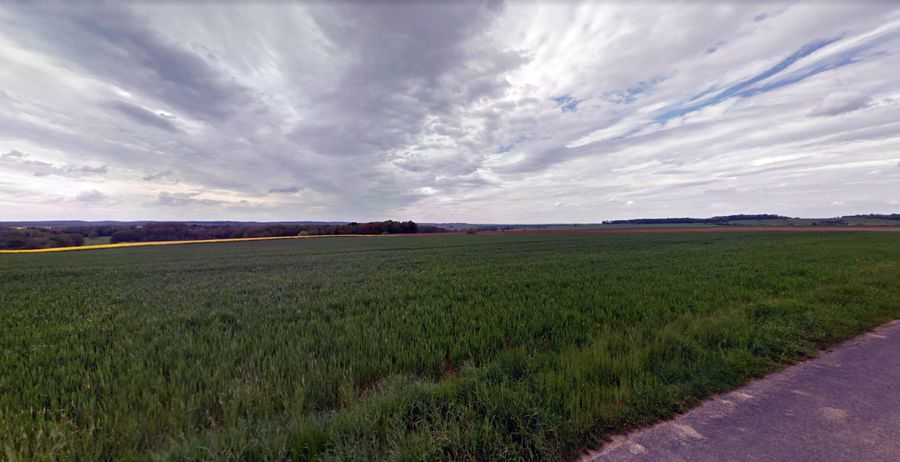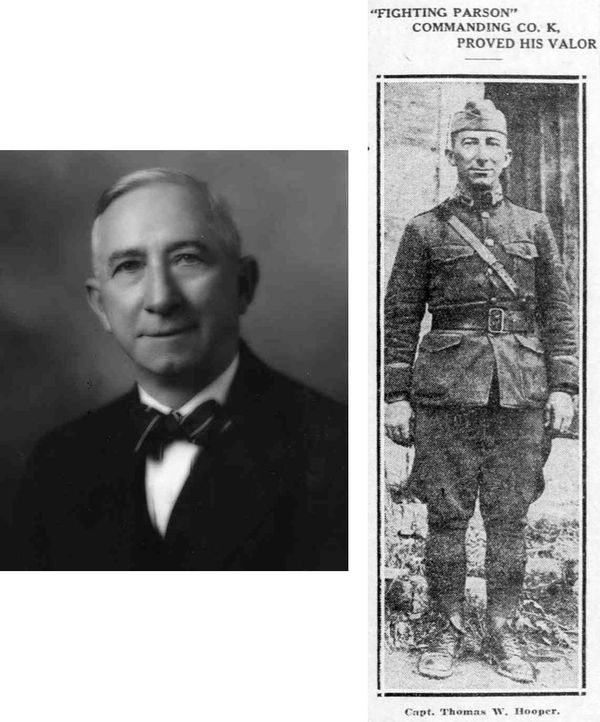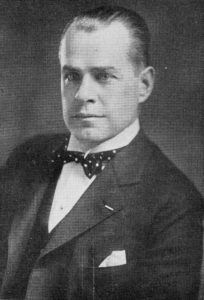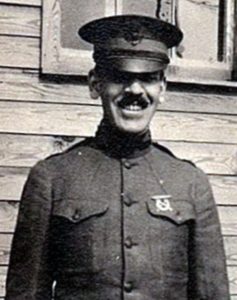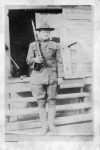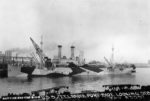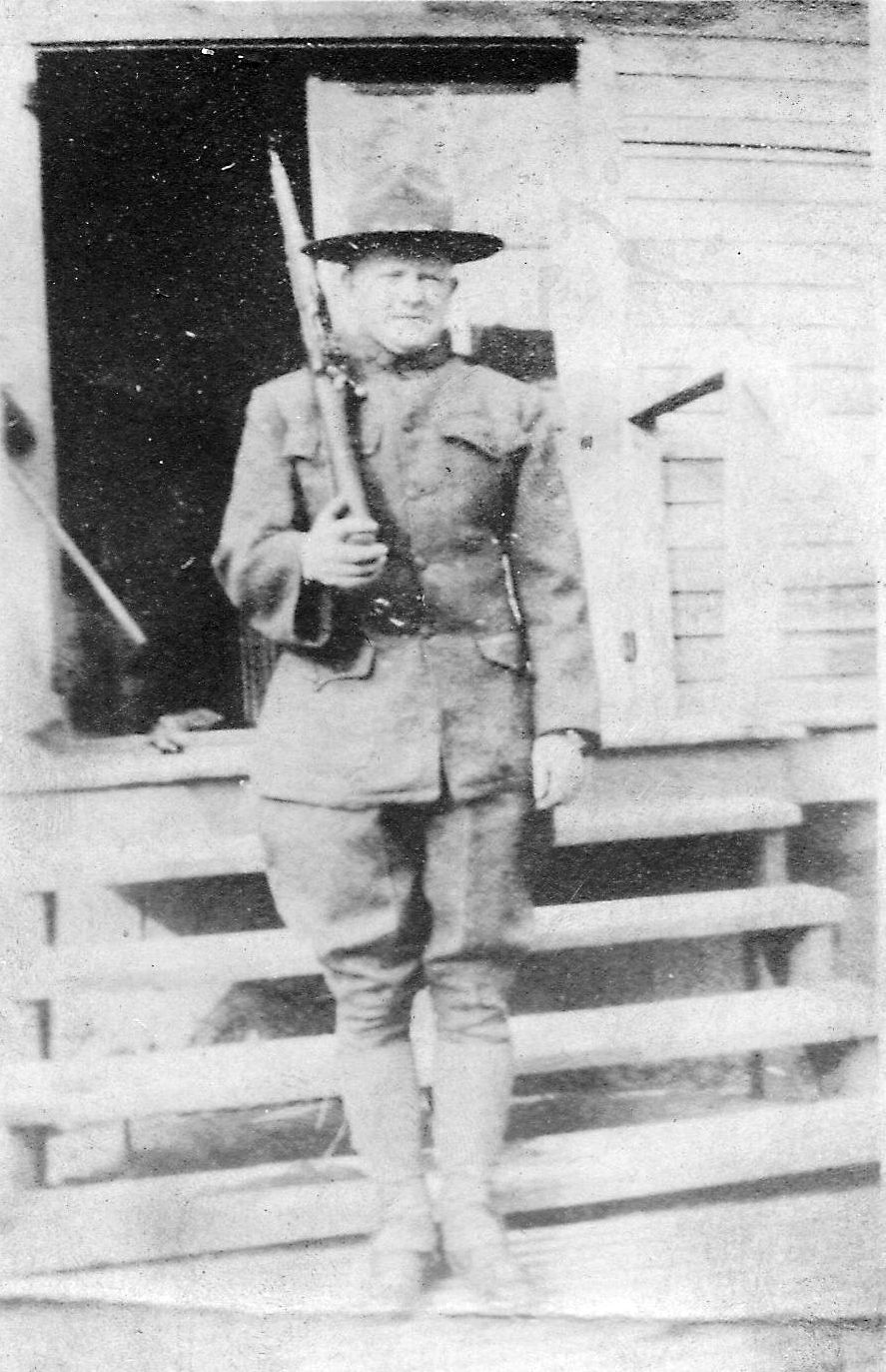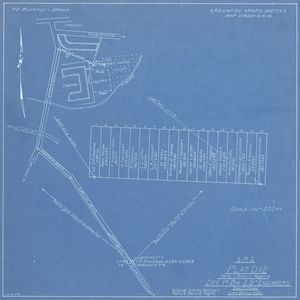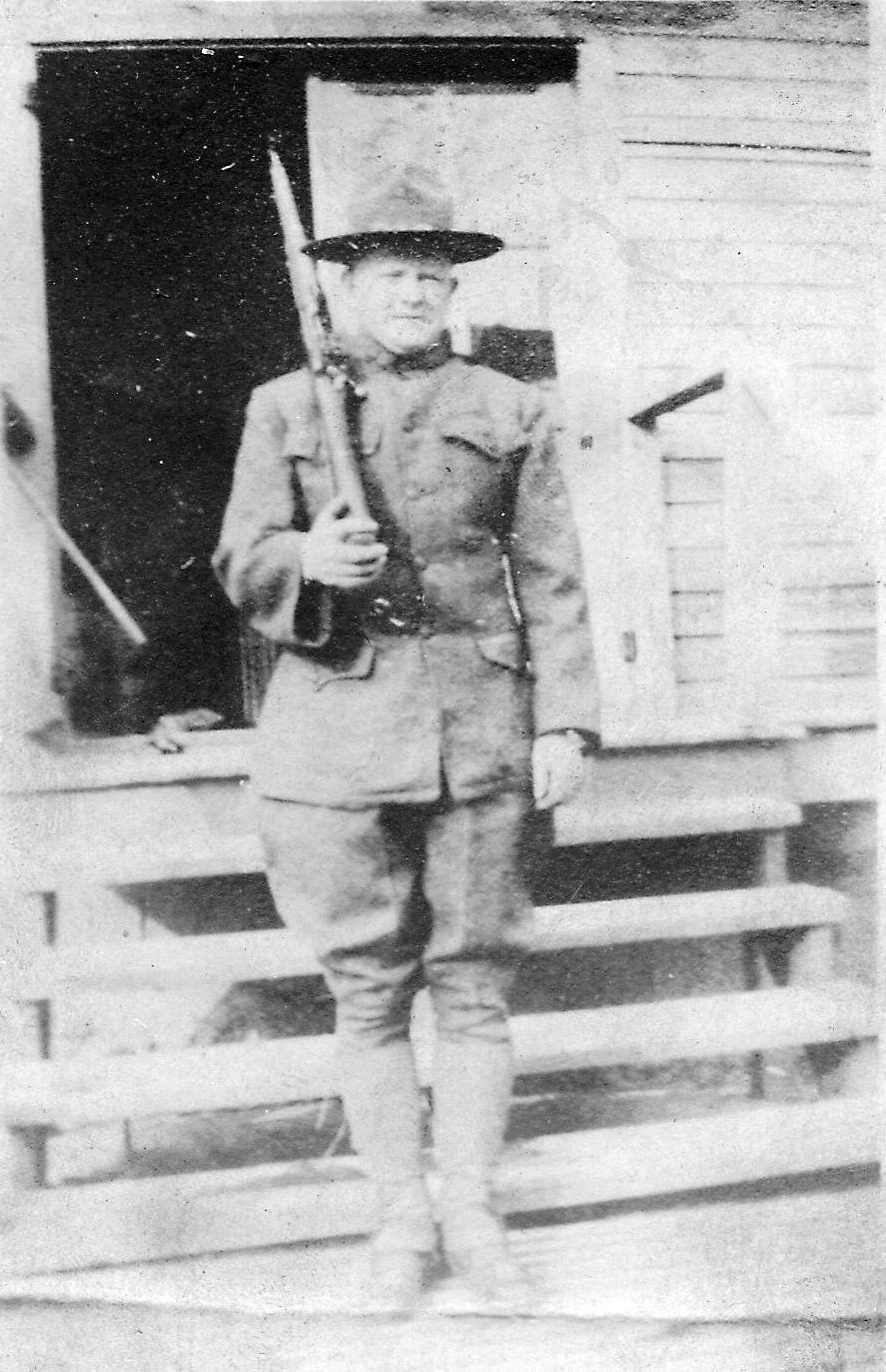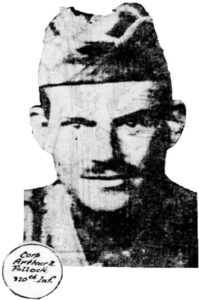Russell Thomas Stewart was my maternal granduncle. He served in the 80th Infantry Division during World War I and was killed in action November 2, 1918. I wanted to know exactly what happened to him, but I doubt anyone ever knew, or could know, precisely what happened that fateful day. In the confusion of battle, most details are never reported or recorded.1 (Refer also to my earlier posts: Russell Stewart: Only Moves Forward and Corporal Pollock’s Account.)
I used Divisional, Regimental and Company histories to piece together his story. I can only estimate where Russell was based on the unit to which he was assigned. It is possible he was separated from his unit and temporarily attached to another unit. It is also possible he died the day before and he was not found until the next day.
Russell served in Company M, one of four companies in the 3rd Battalion of the 319th Infantry.2 The 319th was part of the 160th Brigade in the 80th Infantry Division.
The Meuse-Argonne Offensive was the final battle of World War I. It was fought by the American Expeditionary Forces between the Meuse River and the Argonne Forest in northeast France. Russell fought in all three phases of the Offensive. The 80th Division was the only American division to do so. In the first phase, September 26 through 29, he fought from Bethincourt to Dannevoux. In the second phase, October 4 through 12, he fought from Nantillois to Cunel.
The third phase began November 1 near Sommerance and St. Georges. Russell was almost certainly killed in action the morning of November 2 near the woods northwest of Imécourt. The map below shows the area of interest.3 The vertical blue lines represent the sector to which the 80th Division was assigned.
On the morning of November 1, 1918 the 160th Brigade followed a rolling barrage and led the attack northward from the lower red line. The 320th Infantry was on the left and the 319th Infantry was on the right. Directly north of the 320th was Hill 214 and further north was Alliépont. They encountered severe enemy resistance and did not advance very far all day November 1.
Directly north of the 319th was Imécourt, which they reached about noon on November 1. Some units continued northward to Sivry les Buzancy. The upper red line represents the approximate front line the night of November 1, 1918.
Division History
Veterans of the 80th Division worked for years preparing a division history, but it was not published until 2004.4 I’ve yet to obtain a copy. The American Battle Monuments Commission published a summary of operations for the 80th Division in 1944. It describes the actions generally, that were Russell Stewart’s final moments on November 2, 1918. Again, Russell was in Company M, 3rd Battalion, 319th Infantry, 160th Brigade.
The 80th Division issued two field orders. The first, which was revoked, directed an attack at 5:30 a. m., to be made by the 160th Infantry Brigade. The second was issued in two sections, each covering a phase of the attack. The first section, issued at 1 a. m., November 2, ordered the 160th Infantry Brigade, plus the 317th Infantry and two companies of the division machine-gun battalion, to attack due west at 6 a. m. The assault was to be made by the 319th Infantry, from the general line Imécourt—Sivry, to the objective, the western edge of the wood about 1,500 meters east of Verpel. The attack was to be initiated by a standing barrage on the eastern and southern edges of the wood at 6 a. m. This barrage was to begin to roll toward the western edge at 6:45 a. m. The mission of this phase of the attack was to clean out the divisional zone west of the line, Imécourt—Sivry. The 317th Infantry was to attack in the general direction of Buzancy, supported by the support and reserve battalions of the 320th Infantry.
The second section of the division field orders was issued at 2:30 a. m. ordering the 317th Infantry to attack behind a barrage at 8 a. m., following a 2-hour artillery preparation. This attack was to be supported by the support and reserve battalions of the 320th Infantry. The two companies of the 319th Infantry in position in the woods north of Malmy and the combat-liaison company acting with the 2nd Division were to hold in place and provide flank protection on the right. The battalion of the 320th Infantry in position in the wood on ridge 214 was ordered to remain in position as protection for the left flank.5
This implies the attack prescribed by the second field order was planned, but perhaps not carried out. It goes on to describe an attack not prescribed by field orders. It was carried out by units of the 320th Infantry (160th Brigade) in position south of Alliépont and well south of Russell’s position at Imécourt. Therefore this did not apply to Russell’s unit:
Shortly after midnight, November 1 [meaning November 1-2], an attack not prescribed in the division field orders was begun by elements of the 320th Infantry. Following a 2-hour artillery preparation, the 3rd Battalion, in position in the southern portion of the wood on ridge 214, with two platoons from the 1st Battalion attached as moppers-up and with Company H, 320th Infantry, on its right, supported by Company G, 320th Infantry, moved north through the wood. By 5:15 a. m. these units were advancing north against Alliépont. By 6 a. m. their advanced elements were about 1 kilometer north of Alliépont, where they received orders to halt and hold their gains. They organized a line of resistance along the northern edge of the wood on ridge 214.6
The Division history goes on to describe the “first phase.” It is unclear if this is the first phase of the second field order, or the first phase of the attack not prescribed by any field order. It does describe Russell’s battalion:
The first phase of the operation was carried out by the 3rd Battalion, 319th Infantry, plus Companies E and G. With four companies in the assault echelon and two in support, the attack was launched at 6:55 a. m., and moved west between horizontal grid lines 291 and 292, passing through the woods northwest of Imécourt without encountering resistance. The western edges of the woods were reached about 7:30 a.m. Patrols were sent to Verpel, Thénorgues and Buzancy by 8 a.m.7
This is confusing and it doesn’t provide enough information. For more detail I consulted the 319th Regiment’s Operations Report from October 31 to November 3, 1918.
Captain Charles C. Rossire, Jr. commanded Company F, part of the 2nd Battalion of the 319th Infantry. He was also operations officer. He published a diary of the 319th Infantry after the war. It included the Regiment’s Operations Report.8 Rossire’s battalion led the assault November 1 and into November 2. The 3rd Battalion, Russell’s battalion, was in the support position, and followed closely behind.
[On November 1 at] 11:22 A. M. the town of Imecourt was occupied. Here the troops caught up with the barrage which had been ordered to halt for 1-1/2 hours. The units were ordered to reorganize and continue the attack, the support Bn. ordered to protect our left flank. In the ravine East of Imecourt over 100 Germans surrendered when two [phosphorous] and one rifle grenade were fired at them. The two right companies by employment [of] excellent filtration movement, were sent to follow the barrage to the first day’s objective, where they were ordered to remain to cover the left flank of the Division on our right.
Left support company, assault Bn. held up by a nest of 10 enemy machine guns just after leapfrogging the assault company (8 Maxims and 2 heavy machine guns and 12 dead Germans were counted at this place on Northwest edge of Imecourt next day). Machine gun fire also fell on us from the woods West of Imecourt. The enemy’s failure to get through here was due to rifle grenades and the automatic rifle fire of a platoon which filtered in on the enemy’s rear.
Mention of a “left support company” is unclear. I assume he means one company of the support battalion was held up just after leap-frogging the assault company. I don’t think the support company went ahead of the assault company, except to occupy the Imécourt – Sivry road, perhaps before all companies in the assault Battalion that went forward actually went forward.
The 3rd Battalion, having reached Imecourt, sent Companies L and M to the northern edge of the town. They entered the fight to the left of Companies F and H.9
The enemy attempted a counter-attack and the 2nd Battalion commander, James L. Montague had the 3rd Battalion come up the Imécourt – Sivry road. He asked for a platoon, but two companies were needed. They, including Russell Stewart, fought off counter attacks all afternoon.
[On November 1 at] 12:10 P. M. Enemy attempted to filter across Imecourt – Sivry Road at E9804 with Machine guns and drove back a detachment of engineers who were repairing the road. The Bn. Commander, leading Bn., happened to be at this point at the time and immediately sent for a platoon of the left support company. Seeing the vitality of the position, 2 companies of the support Bn. were also placed along the road at this point. This position lay off the flank of the reserves of the Division to our right. All that afternoon, repeated attempts were made by the enemy to force an opening at this position. Here again rifle grenades were used with great effect.
This photograph of troops taking cover near Imécourt was taken where Russell Stewart was, while he was there. Notice a few of their helmets.
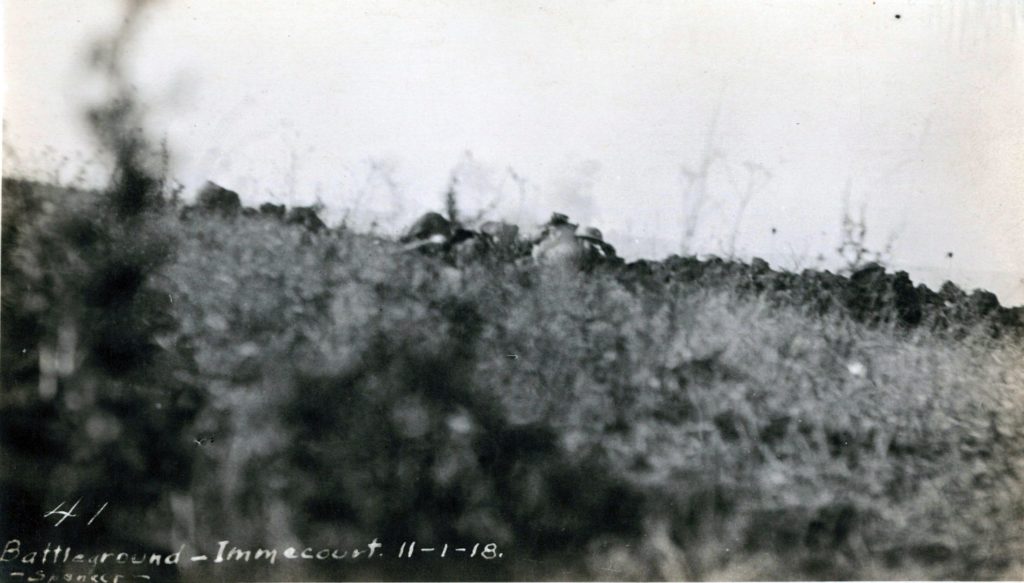 Battleground – Immecourt 11-1-18.10
Battleground – Immecourt 11-1-18.10
Other remarks in the Operations Report describe the conditions encountered November 1:
Enemy with hands up, apparently ready to surrender, opened fire when he came within 30 or 40 yards. No “Booby traps” seen.
Evening of Nov. 1st, the Bn. Commander saw about 300 enemy infantry in woods in square 80 and 81 West of Imecourt.
Our communications to rear excellent except on one or two occasions when enemy put down a wide belt of [poison] gas.
The 3rd Battalion, in which Russell Stewart served, continued to cover the rear and left flank of the assault battalion during the night.
Enemy machine gun fire continued on our front until 4:30 A. M. 2nd Nov. The front was outposted and patrolled during the night. At 8:30 P. M. patrols reported a large number of enemy moving towards Alliepont. Our rear and left was covered by our machine guns and whole of the support Bn.
The Operations Report mentions that the first order for a westward flanking attack was revoked. A second order called for a barrage starting at 6:00am followed by a westward attack at 6:55am to include companies from both the 2nd and 3rd Battalions.
2nd Nov., 1918, 4:30 A. M. Orders received to resume attack at 5:30 A. M. At 5:10 A. M. above order was revoked and the two companies of the 2nd Bn. in conjunction with the 3rd Bn. were ordered to attack the woods in Square 80 and 81 from the East at 6:00 A. M., following a barrage.
The two companies of the 2nd Bn. abreast of the 2 companies of the 3rd Bn. moved out at 6:55. Two companies of the 3rd Bn. protected our left. Reserve Bn. covered and protected left rear.
It also says no resistance was encountered:
7:30 A. M. the wood was occupied without resistance. By 8:00 A. M. patrols were on the way to Verpel, Thenorgues and Buzancy, and outposts covered the Rau de St. Georges. Our patrols reached those towns before they were occupied by other troops.
Regimental History
Both the Division’s account and the 319th Infantry’s Operations Report indicates “no” resistance was encountered in this flanking attack. However a regimental history describes it as follows. Take note the enemy machine gun fire had ceased about 4:00am.
A reorganization was effected during the night [of November 1], and at 5:00 a.m. the regiment attacked towards the west, to clear the woods northwest of Immecourt. The enemy, whose machine gun fire had ceased about 4:00 a.m. was discovered to have abandoned the woods, but his artillery put down a heavy fire therein during the advance. Passing through the woods, the regiment halted and patrols were sent into Verpel and Buzancy, both towns being found free of the enemy.11
This implies that although there were no enemy soldiers present, the enemy continued to shell the woods during the advance.
Company History
Company F, commanded by Captain Charles Rossire, was one of the advanced units positioned near Sivry, and did not participate in the flanking attack. But, its history corroborates the enemy shell fire and also that our own artillery was active that morning:
Early on the morning of the 2nd our barrage started up. It was falling close to our position and for safety the troops withdrew three hundred yards, later they advanced to the top of the hill and in a driving rain, started to dig in. The German shell fire added to the hardships. About 9.30 a.m. the 159th Brigade passed through our lines to take up the attack.12
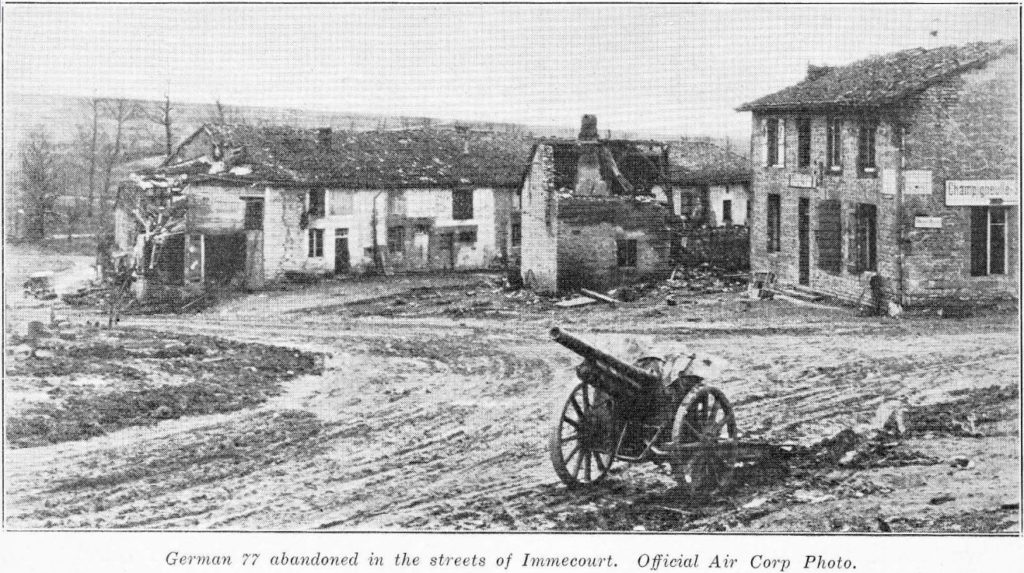 Ruins of Imécourt with captured artillery piece.13
Ruins of Imécourt with captured artillery piece.13
An Initial Conclusion
Russell Stewart probably participated in the westward flanking attack that started about 7:00am and concluded by 7:30 or a little later. He was therefore probably killed by enemy artillery fire while traversing the woods west of Imécourt. He otherwise would not have encountered resistance.
It seems though that every account is slightly different and gives differing time frames. There was confusion, both in the various field orders, and in accounts afterward. Luckily I happened upon an even more detailed account published after the war.
The Unsung General Brett
Lieutenant Colonel Jennings C. Wise wrote an article commending Brigadier General Lloyd M. Brett, who commanded the 160th Brigade, in which Russell served. He felt Brett did not receive adequate credit for devising the plan of attack that was carried out November 2:
…The episode which I shall describe herein is one which as a member of the One Hundred and Fifty-ninth Infantry Brigade I witnessed in its local aspects without any knowledge of the general operation of which it was a part, but which later as a member of the Historical Section of the General Staff with all the official evidence before me, I took occasion to study in its detailed relation to the major operation of the First American Army initiated on November 1, 1918. The belief which as a witness I formed on the battlefield that the action of the Eightieth Division on November 2 was not only of extraordinary importance, but of exceptional merit, was only confirmed by subsequent studies, which disclosed to me the parts which these several leading actors played therein, and convinced me that the services, on that occasion of Brig Gen. (now Colonel) Lloyd M. Brett, retired, comprise the most striking brilliant independent tactical action of importance on the part of the individual which occurred in the entire American Expeditionary Force, except none.
…With the utmost confidence in Brett’s estimate of the situation, [Maj. Gen. Adelbert Cronkhite] ordered forward the Three Hundred and Seventeenth Infantry from reserve to take over the front of the Three Hundred and Nineteenth Infantry in the line abreast of the Second Division, the Three Hundred and Eighteenth Infantry to follow in close support, the Three Hundred and Twentieth Infantry to press forward, and the Three Hundred and Nineteenth Infantry to attack squarely toward the left, or west, at the first practicable moment. Thus, on the morning of the second the three regiments of the Eightieth Division in the front line were to advance independently, attacking in two directions at right angles to each other, the attack of the Three Hundred and Seventeenth Infantry toward the north, or Buzancy, to cover the left flank of the center corps, thereby making the further advance of the center and the right wing possible without delay in the prescribed schedule, and the attack of the Three Hundred and Nineteenth Infantry to the west to relieve the pressure on the left wing, thus enabling it to come forward into line and catch up with the schedule of the lineal attack of the entire First Army.
The operation was entirely successful. By 4 a. m. on November 2 the Three Hundred and Nineteenth Infantry had delivered its attack under the personal direction of Gen. Brett in exact accordance with the plan of those who designed it, clearing out the wood north of Alliepont, and sweeping westward north and in rear of Champineulle, Three Hundred and Fifteenth Machine Gun Battalion in position on the Immecourt ridge being utilized to cover the necessary changes of position and deployment of the infantry units. So soon as the pressure of the Three Hundred and Nineteenth Infantry was felt on his left flank the enemy vigorously pressed by the Three Hundred and Twentieth Infantry from the south, abandoned Champineulle and the Bois-des-Loges in turn, falling back rapidly in a north-westerly direction through Briquenay to the line Buzancy-Bar-Harricourt, which was already seriously threatened at Buzancy by the One Hundred and Fifty-ninth Brigade, which captured the town early on the morning of the third. Before noon the One Hundred and Sixtieth Brigade had taken Verpel and Thenorgues, and soon thereafter the Seventy-seventh and Seventy-eighth divisions were able to come into line abreast of the Eightieth, having passed through the once formidable positions of Champineulle and the Bois-des-Loges without serious resistance. By nightfall the entire line of the First Army had been rectified and brought up to schedule, so that it now extended from the Meuse near Clery due westward through Sivry-le-Buzancy to Barricourt. the Seventy-eighth, or extreme left division, having been squeezed out of the line. Contact with the French on the left near Germont was complete….
…Hardly had the corps and Army commanders discovered the miscarriage of their plans for the first day of the general attack when they learned with mingled surprise and delight of what had occurred before daybreak on the second….14
Thus there was a significant battle in the woods west of Imécourt early in the morning of November 2 and it was fought by the 160th Brigade. It precipitated the German withdrawal from the sector. The enemy had not already withdrawn, as indicated in the division history. Interestingly, Wise states it was over by 4:00am, the time the regimental history says machine gun fire from the woods stopped.
Other evidence corroborates this account. First there were at least 21 killed in action in the 319th Infantry on November 2, more than expected for an advance through the woods with “no” resistance. Second, the high command immediately praised General Brett via telegram the same day, November 2. Such praise was rare, and is unlikely for an attack with “no” resistance. Although, he could be referring to actions on both November 1st and 2nd:
Telegram from the Commanding General, First Army Corps, 2 November 1918: “The Corps Commander is particularly pleased with the persistent, intelligent work accomplished by your Division today. He is further desirous that his congratulations and appreciation reach General Lloyd M. Brett, commanding your Brigade [160th], which has borne the brunt of the burden.”15
So the 160th Brigade, which included the 319th and 320th Regiments, bore the brunt of the burden. Another error reveals evidence that it was not only the 160th Brigade, but specifically the 3rd Battalion in that brigade that fought so valiantly November 2. Russell was in Company M of the 3rd Battalion.
The Unsung Second Battalion
Captain Charles C. Rossire, Jr. wrote a letter in September 1920 to the Adjutant General of the Army, which was published in The Service Magazine.16 He wanted to correct an error in General Pershing’s report regarding the position of the 80th Division the night of November 1, 1918. He wanted the record to reflect his company, Company F, had reached the day’s objective.
In support of this, Major James L. Montague, who commanded the 2nd Battalion that led the assault that day, provided an affidavit that affirmed Captain Rossire’s account:
That the letter of Charles C. Rossire, formerly Captain Co. F, 319th Infantry, 80th Division, to the A. G. of the Army, is correct to the best of my knowledge and belief.
That Companies F and H, 319th Infantry, did reach the line specified in Captain Rossire’s letter on the afternoon of November 1, 1918, and that I was personally with these companies when they were advancing a few yards south of Sivry Les Buzancy-Bayonville et Chennery road, and gave orders to Captain Keezell to continue to the day’s objective.
That Co. E, 319th Infantry, and one platoon commanded by Second Lieut. Hopkins, deceased, Co. K, 319th Infantry, covered the western flank of the regimental sector along the Immecourt-Sivry road from 5 P. M. November 1, to 6 A. M. November 2, 1918.
That on the morning of November 2, patrol of the 319th Infantry, which I sent out, reached the towns of Verpel and Thenorges in advance of any other American Troops.17
Here again is mention of the patrols sent to Verpel and Thénorgues. This affidavit prompted a response from the commander of the 3rd Battalion.
The Unsung Third Battalion
Captain Thomas W. Hooper commanded the 3rd Battalion. He took issue with Major Montague’s affidavit in a letter published in the next issue of The Service Magazine:18
…Capt. Rossire has already had corrected that part of the account which told of the objective reached. His article in Service giving the correspondence on that subject is perfectly correct, except that the affidavit of Maj. Montague again does not give the 3rd Battalion credit for what it did.
He states that his battalion, with one platoon of K Company held the left of the regimental sector along the Imecourt-Sivry road. As a matter of fact, when the two companies of his battalion that advanced to the neighborhood of Sivry had left Imecourt, the Germans attempted a bit of a counter attack. The whole of the 3rd Battalion was thrown out around Imecourt and along the Imecourt-Sivry road to protect the left flank of those two companies. They held this position all during the night of Nov. 1 and 2.
The attack of Nov. 2nd, on the woods northwest of Imecourt was made chiefly, if not entirely, by the 3rd Battalion, 319th Infantry. By Capt. Rossier’s statement, two companies of the 2nd Battalion were held in Sivry until that night, and if the other two companies of the [2nd] battalion were in the advance of Nov. 2nd, I did not see them. It was the 3rd Battalion that immediately sent out the patrols. It is not the intention of these corrections to take any glory from a single man, but in the interests of truth they should be made.
From this we learn Russell’s unit was positioned around Imécourt and it was his battalion that attacked early in the morning of November 2. Lieutenant Colonel Wise, who did a detailed study of General Brett’s plan, states that attack concluded successfully by 4:00am. It seems other units, perhaps from the 2nd Battalion, were ordered westward later in the morning, and indeed they did not encounter resistance.
As late as 1928, Major Montague maintained his recollection of events, even in light of the objections raised by Captain Hooper back in 1921. Although, this account may have been re-published from an earlier time:
…My left company got held up a bit, but they flanked the wood where the machine gun nests were and forged ahead. I ordered the barrage to halt an hour and a half and we caught up with it at Imecourt. Here we got 200 prisoners. The regiment on my left [the 320th] was still at the jumping-off place, and fearing a flank attack I held two companies here and sent the other two on to the final objective, which was just northeast of Sivry. They got there and took a lot of Huns and artillery. My battalion took 600 prisoners, 33 cannon, and perhaps 300 machine guns. In the meantime we were having all we could do to hold Imecourt. They tried to get in behind my two forward companies, and I had to hold them off with my old .45 Colt, while I sent back for one of Hooper’s companies [3rd Battalion] to fill in the gap. All afternoon and part of the night the Hun tried to break through. We had created a huge pocket and were fixing to sew it up, but during the early morning of the 2nd, while orders were moving hot and fast, the Hun pulled out. By 10 a. m. I had patrols in Verpel, Thenorgnes, and Buzancy. The 159th passed through us and continued the fight.19
Major Montague hints there was confusion and a flurry of orders. He stated in his earlier affidavit he was personally with the two companies that continued north to Sivry. Therefore he was not at Imécourt in the early morning hours when the 3rd Battalion attacked, and he may not have known about it.
Why the discrepancy and why is the official record incomplete? The 80th Division had about 26,000 men, while a single Company in the Division had about 250 men. It is impossible to summarize in a paragraph what every unit did and when. What one Company experienced was not necessarily known to other Companies, even if they were only a quarter mile away. My guess is there were a few individuals assigned to create these histories and they had limited information.
In the case of Russell’s battalion however, Captain Hooper alluded to another reason:
From our days in Camp Lee, it seemed that there was some sort of suspicion of the 3rd Battalion, 319th Infantry, which the writer has never yet been able to understand. Certainly, the credit for the part that this battalion took in the fighting has not been given it….20
General Brett moved the 160th Brigade command post to Imécourt on November 2, 1918, where it stayed until November 4.21 During the same time the 80th Division was also headquartered there.
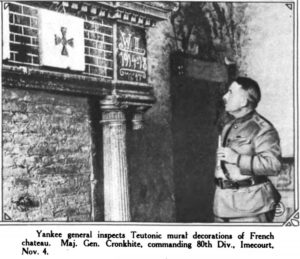 Major General Cronkhite, commander of the 80th Division, at Imécourt.22
Major General Cronkhite, commander of the 80th Division, at Imécourt.22
Further Details
The Operations Report provides the text of some messages sent during the advance. One was issued as the lead battalion was about to enter Imécourt. It illustrates how confusion in whereabouts can affect the interpretation of what happened.
“We have information that your advanced Battalion is North of parallel 289. You will take your support Bn. [3rd Battalion] (with the reserve M. G. Co. [Machine Gun Company]) for a flanking movement on woods around Hill 214 and North. Lt. Cannon, the bearer of this will go with one of your staff officers to your support Bn. to guide it into position. You will not wait for the reserve M. G. Co., but send it up as soon as possible. Rush. Brett.” Complied with at 11:25.23
Hill 214 is south of Alliépont and southwest of Imécourt, where the 320th Infantry was halted by severe resistance. This must be the order that Captain Hooper alludes to when he says he never received it:
As to the engagement on Nov. 1st, no battalion attacked the woods in front of the 320th from the east. The commanding general, 160th Brigade, sent the order, I am informed, through the commanding officer, 319th Infantry, for the 3rd Battalion, 319th Infantry, which I at that time commanded, to make that attack. As a matter of fact, that order has never yet reached me. That is the reason the attack was not made. It would have been a beautiful piece of tactics and one easily executed from my position as support battalion in the 319th sector. It is true that the battalion did later become engaged at the front, but that was not the reason for not attacking the woods in front of the 320th Infantry.24
Although the Operations Report indicates the order was complied with at 11:25am, it was actually just forwarded. The staff officer thereafter could not find the 3rd Battalion where he expected them to be and instead found them already deployed at Imécourt. The order was subsequently revoked.
…received 11:05 was complied with at 11:25 by sending staff officer forward….
…Officer reached position where P. C. support Bn. was last reported to be, and not finding Bn. went forward to outskirts of town of Imecourt. At 12:10 he found support Bn. had been called upon to reinforce front line Bn. and make attack enveloping enemy’s counter attack. He returned to position South of Imecourt….
…orders of the staff officer were revoked and he was ordered to return to the regimental P. C….25
Field Order 22, the text of which was not published, must have been the order for the “second” westward flanking attack carried out later in the morning, and the one referenced by other accounts stating there was “no” resistance. “Hayes” is the code name of the 160th Brigade:
F. O. No. 22 Hayes Nov. 2, 1918, complied with 6:00 A. M. Nov. 2, 1918 No resistance met.26
There seems to have been two westward flanking attacks: General Brett’s, that was independent of higher command, was completed by 4:00am. The second was another order by the 160th Brigade for an attack that began at 6:00am. A few hours after Brett’s attack, the second attack met no resistance.
Final Conclusion
From all these accounts we learn Russell Stewart was in the support battalion that followed the assault battalion closely during the attack of November 1. He almost certainly deployed the afternoon and night of November 1st at Imécourt and defended the village from several German counter-attacks. In the early morning hours of November 2nd, he took part in an active battle in the woods west of Imécourt and north of Alliépont. It was this battle that precipitated the German retreat that morning. He likely died before 4:00am during heavy fighting on the approach to, or in, the woods northwest of Imécourt.
This map shows the weight and direction of principal attacks in November.27 A major attack was indeed made westward from Imécourt (south of Buzancy) by the 80th Division. It allowed the 77th and 78th Divisions to advance.
Another map shows the front line the night of November 1 on the outskirts of Imécourt, where Russell was positioned.28 The woods through which he fought and died is indicated at left by a star.
The dashed line between Imécourt and Sivry-les-Buzancy represents a gap tenuously held by patrols the night of November 1st. The 3rd Battalion surrounded Imécourt and went a short way up the Imécourt – Sivry road, but it did not meet the forward units of the 2nd Battalion at Sivry.
The following is a rare map that shows both the likely area where Russell Stewart was killed and the enemy positions he probably encountered.29 It is “Battle Message” that was carried into battle and used to send quick messages back to the command post. It seems to be centered on the area assigned to the 80th Division and probably intended for the third phase of the Meuse-Argonne Offensive that began November 1, 1918. Therefore Russell’s unit probably carried sheets like this one.
Following that, I provide another copy of the same sheet with color highlighting to illustrate points of interest.
The dark blue vertical lines denote the narrow corridor to which the 80th Division was assigned. The front line, or jump off, of November 1, 1918 is shown by the purple line at bottom. The 160th Brigade went over the top at 5:42am. The 320th Regiment was on the left and the 319th Regiment (Russell’s) was on the right. By 6:00pm, not much progress had been made on the left, but the 319th fought its way to Imécourt. Some companies made it to Sivry, which extended the front considerably northward that night. Russell, in the 3rd Battalion, 319th Regiment remained at Imécourt and defended it from German counter-attacks.
The red circles denote the numerous enemy positions both known and estimated, including foxholes, trenches, machine gun emplacements and artillery batteries. Russell’s unit would have faced stiff resistance as it made its way northward during the day on November 1.
The large pale blue area in the middle depicts the westward flanking attack conducted by the 3rd Battalion early in the morning November 2, 1918. It too faced stiff enemy resistance on the approach to the wooded area, and probably within the woods. Russell was probably killed in action here.
A modern satellite image30 shows the woods northwest of Imécourt as the dark green area at center. It has not changed appreciably in 100 years.
A modern “street view” looking west towards Vepel shows the gently rolling countryside with the woods in the distance.31 Several high areas to the right provided a good vantage point for enemy defenses.
Heroes During the War, and After
Captain Hooper, Lieutenant Colonel Wise, and Major Rossire all spoke up after the war in the interest of truth and future generations. Without their help the story of how Russell Stewart died would be incomplete.
Captain Thomas W. Hooper commanded the 3rd Battalion of the 319th Infantry, 160th Brigade, 80th Division during the third phase of the Meuse-Argonne Offensive. Prior to that he commanded Company K in that battalion.
He was known as the “Fighting Parson” because he was pastor at Mitchells Presbyterian Church in Culpeper, Virginia both before and after the war.32 He wrote the letter 33 from which we can infer Russell Stewart was at Imécourt and was among the companies that attacked due west on November 2, 1918.
The newspaper photo above, right, was taken from an official army photograph.3435
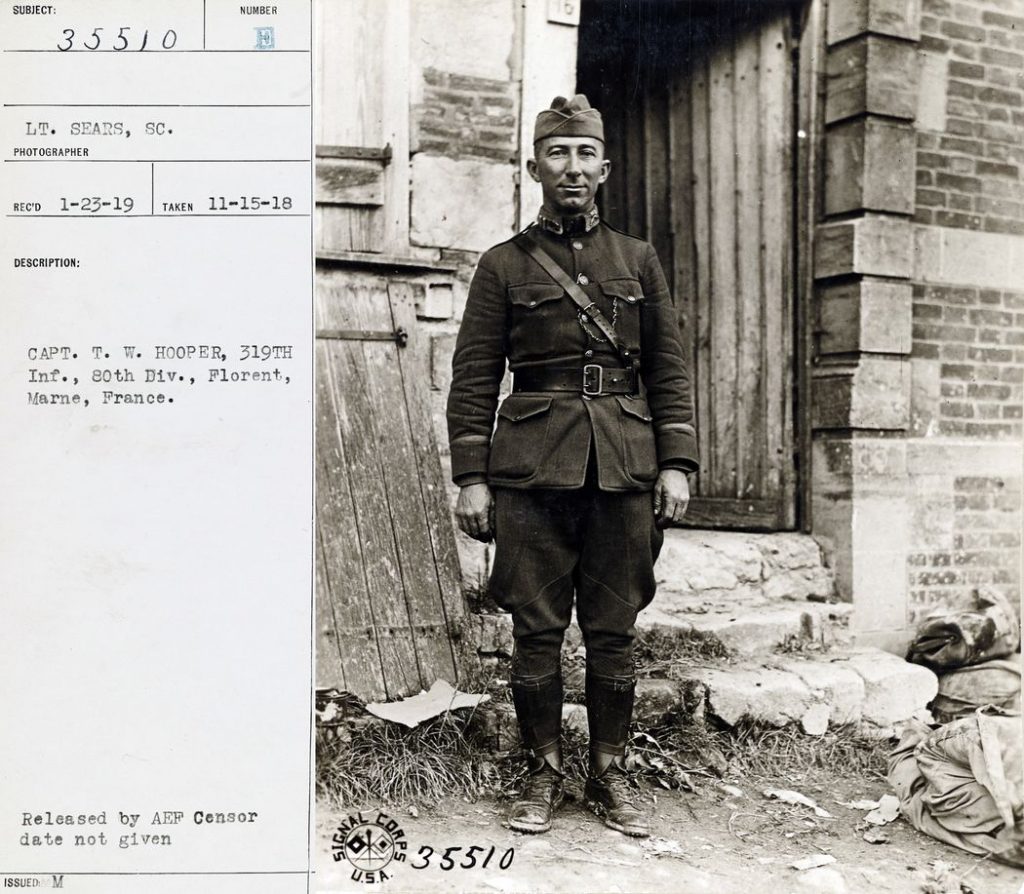
Lieutenant Colonel Jennings C. Wise was a member of the 318th Infantry, 159th Brigade, 80th Division. He later became a Lieutenant Colonel and was a member of the Historical Section of the General Staff.
He researched General Brett and the attack of November 2, 1918. He wrote the article from which we can infer Russell Stewart was killed in action during an early morning attack November 2, 1918.36 He was also an author who wrote several books.37
Major Charles C. Rossire, Jr. was Regimental Supply Officer, commanded Company F as a Captain, and was Operations Officer, in the 319th Infantry, 80th Division. He kept and wrote much of the history of the 319th Infantry, from which we know its precise movements.38
He was cited for meritorious services and extraordinary gallantry in action: “Captain Charles C. Rossire, Co. F, 319th Infantry. For conspicuous gallantry in action near Imecourt, France. November 1st, 1918. Captain Rossire by his persistent leadership and personal gallantry fought his way to the first day’s objective unselfishly exposing himself on two separate occasions in directing the attacks on the strong enemy positions that were holding up the advance of the Regiment. In spite of the fact that his flank was badly exposed he succeeded in capturing, with his Company, two hundred and fifteen men, several machine guns and cannon.”
He was later awarded the Distinguished Service Cross: “The President of the United States of America, authorized by Act of Congress, July 9, 1918, takes pleasure in presenting the Distinguished Service Cross to Captain (Infantry) Charles C. Rossire, Jr., United States Army, for extraordinary heroism in action while serving with 319th Infantry Regiment, 80th Division, A.E.F., near Imecourt, France, 1 November 1918. His company being halted by enemy machine-gun fire, Captain Rossire secured two hand grenades and rushed alone for an enemy machine-gun nest, throwing his grenades and compelling the surrender of the gun crews. Returning to his company, he directed the fire upon the remaining machine-gun crews, which were causing heavy casualties in his company, silenced the enemy guns, and resumed the advance with minimum losses. The soldierly courage displayed by Captain Rossire greatly inspired the members of his company.”
Footnotes- Photo from Dennis Stewart, MyHeritage.com, Robert M. Stewart Family (https://www.myheritage.com/site-148784861/robert-m-stewart-family : Downloaded 23 June 2016), Thomas Russell Stewart.
- “Pennsylvania, WWI Veterans Service and Compensation Files, 1917-1919, 1934-1948,” database online, Ancestry.com Operations, Inc., 2015, Ancestry.com (http://ancestry.com: Downloaded 6 July 2016), Stewart, Russell T; citing World War I Veterans Service and Compensation File, 1934–1948. RG 19, Series 19.91. Pennsylvania Historical and Museum Commission, Harrisburg Pennsylvania.
- Buzancy 1:20,000, Sheet 60, Pritzker Military Museum and Library, Hunter Collection, Map 00857, Item 600996, OCLC 932128955 (http://cdm16630.contentdm.oclc.org/cdm/ref/collection/p16630coll8/id/134 : viewed September 6, 2018).
- Russell L. Stultz, History of the Eightieth Division, A.E.F. in World War I, Lee S. Anthony, Editor, Descendants of the 80th Division Veterans, 2004.
- American Battle Monuments Commission. 80th Division: Summary of the Operations in the World War. United States Government Printing Office, 1944, page 44-45.
- American Battle Monuments Commission. 80th Division: Summary of the Operations in the World War. United States Government Printing Office, 1944, page 44-45.
- American Battle Monuments Commission. 80th Division: Summary of the Operations in the World War. United States Government Printing Office, 1944, page 45.
- Major Charles Rossire, Jr., “A Brief Diary of the 319th Inf.,” With a Short Foreword by the Author, an article in “The Service Magazine,” Volume 4, Number 4, February-March 1923, pages 7-10. 80th Division Veteran’s Association (https://www.80thdivision.com/blueridge_wwi.html : viewed September 6, 2018).
- American Battle Monuments Commission. 80th Division: Summary of the Operations in the World War. United States Government Printing Office, 1944, page 40-41.
- Larry R. Kephart, “Diary of William A. Livergood. A tale of a soldier who served in the World War in France,” (http://www.laroke.com/larryk4674/2001/poppop.htm : downloaded 31 Oct 2018).
- Josiah C. Peck, The 319th Infantry A.E.F. Paris: Clarke, 1919, page 37.
- Charles Herr. Company F History, 319th Infantry: Pub. as a Matter of Record by the Officers and Men of the Company. Somerville, NJ: Unionist-Gazzette Association, 1920, page 54.
- Photo from “Two Soldiers of the 80th Who Still ‘Carry On’,” an article in “The Service Magazine,” Volume 3, Number 5, July-August 1928, page 15. 80th Division Veteran’s Association (https://www.80thdivision.com/blueridge_wwi.html : viewed September 6, 2018).
- Jennings C. Wise, “General Brett and the Fighting ‘80th’,” How the Gallant Leader of the 319th and 320th Regiments of Infantry and 315th Machine Gun Battalion Played a Leading Role of the Bitterly Fought Battles of the World War, Facts Presented to Congressional Committee in Effort to Win Merited Rank for General Who Led Pittsburghers Through Decisive Phases of War, an article in “The Service Magazine,” Volume 3, Number 10, August 1922, pages 7-9, 31. 80th Division Veteran’s Association (https://www.80thdivision.com/blueridge_wwi.html : viewed September 6, 2018).
- “The Record of the ‘80th’,” a portion of General Order No. 19, Headquarters Eightieth Division, American Expeditionary Forces, France, 11 November, 1918, an article in “The Service Magazine,” Volume 3, Number 5, February 1922, page 13. 80th Division Veteran’s Association (https://www.80thdivision.com/blueridge_wwi.html : viewed September 6, 2018).
- Capt. Chas. C. Rossire, Jr., “The Truth of the Matter,” Being the Efforts of Those Who Were in a Position to Know the Exact Accurate Historical Facts Concerning the Movements of the Eightieth in the A. E. F., an article in “The Service Magazine,” Volume 2, Number 3, December 1920 – January 1921, pages 14-15. 80th Division Veteran’s Association (https://www.80thdivision.com/blueridge_wwi.html : viewed September 6, 2018).
- Capt. Chas. C. Rossire, Jr., “The Truth of the Matter,” Being the Efforts of Those Who Were in a Position to Know the Exact Accurate Historical Facts Concerning the Movements of the Eightieth in the A. E. F., an article in “The Service Magazine,” Volume 2, Number 3, December 1920 – January 1921, pages 14-15. 80th Division Veteran’s Association (https://www.80thdivision.com/blueridge_wwi.html : viewed September 6, 2018).
- Thomas W. Hooper, “The Truth of the Matter,” Being the Efforts of Those Who Were in a Position to Know the Exact Accurate Historical Facts Concerning the Movements of the Eightieth in the A. E. F., an article in “The Service Magazine,” Volume 2, Number 4, February 1921, pages 15, 26. 80th Division Veteran’s Association (https://www.80thdivision.com/blueridge_wwi.html : viewed September 6, 2018).
- Maj. James L. Montague, “Memoirs: Second Battalion, 319th Infantry Regiment, Eightieth Division, A. E. F.”, an article in “The Service Magazine,” Volume 9, Number 4, July-August 1928, pages 18, 38. 80th Division Veteran’s Association (https://www.80thdivision.com/blueridge_wwi.html : viewed September 6, 2018).
- Thomas W. Hooper, “The Truth of the Matter,” Being the Efforts of Those Who Were in a Position to Know the Exact Accurate Historical Facts Concerning the Movements of the Eightieth in the A. E. F., an article in “The Service Magazine,” Volume 2, Number 4, February 1921, pages 15, 26. 80th Division Veteran’s Association (https://www.80thdivision.com/blueridge_wwi.html : viewed September 6, 2018).
- “Station List Headquarters 160th Infantry Brigade with the A. E. F.,” an article in “The Service Magazine,” Volume 8, Number 4, July-August 1927, page 30. 80th Division Veteran’s Association (https://www.80thdivision.com/blueridge_wwi.html : viewed September 6, 2018).
- William Emmet Moore and James Clayton Russell, U. S. Official Pictures of the World War, Showing America’s Participation, Washington, DC: Pictorial Bureau, 1920, about page 344.
- Major Charles Rossire, Jr., “A Brief Diary of the 319th Inf.,” With a Short Foreword by the Author, an article in “The Service Magazine,” Volume 4, Number 4, February-March 1923, pages 7-10. 80th Division Veteran’s Association (https://www.80thdivision.com/blueridge_wwi.html : viewed September 6, 2018).
- Thomas W. Hooper, “The Truth of the Matter,” Being the Efforts of Those Who Were in a Position to Know the Exact Accurate Historical Facts Concerning the Movements of the Eightieth in the A. E. F., an article in “The Service Magazine,” Volume 2, Number 4, February 1921, pages 15, 26. 80th Division Veteran’s Association (https://www.80thdivision.com/blueridge_wwi.html : viewed September 6, 2018).
- Major Charles Rossire, Jr., “A Brief Diary of the 319th Inf.,” With a Short Foreword by the Author, an article in “The Service Magazine,” Volume 4, Number 4, February-March 1923, pages 7-10. 80th Division Veteran’s Association (https://www.80thdivision.com/blueridge_wwi.html : viewed September 6, 2018).
- Major Charles Rossire, Jr., “A Brief Diary of the 319th Inf.,” With a Short Foreword by the Author, an article in “The Service Magazine,” Volume 4, Number 4, February-March 1923, pages 7-10. 80th Division Veteran’s Association (https://www.80thdivision.com/blueridge_wwi.html : viewed September 6, 2018).
- American Battle Monuments Commission, American Armies and Battlefields in Europe: A History, Guide and Reference Book (US Government Printing Office, 1938), American Battle Monuments Commission, Meuse-Argonne American Cemetery, Publications, (https://www.abmc.gov/cemeteries-memorials/europe/meuse-argonne-american-cemetery : downloaded September 7, 2018), page 186.
- American Battle Monuments Commission, American Armies and Battlefields in Europe: A History, Guide and Reference Book (US Government Printing Office, 1938), American Battle Monuments Commission, Meuse-Argonne American Cemetery, Publications, (https://www.abmc.gov/cemeteries-memorials/europe/meuse-argonne-american-cemetery : downloaded September 7, 2018), page 276.
- Map of Buzancy, Pritzker Military Museum and Library, Hunter Collection, Map 00828, Item 600967, OCLC 930887882 (http://cdm16630.contentdm.oclc.org/cdm/ref/collection/p16630coll8/id/113 : viewed September 6, 2018).
- Google Earth.
- Google Maps.
- Donnie Johnston, Culpeper [Virginia] Star Exponent, “Mitchells Presbyterian set to celebrate 150 years in Culpeper, October 10, 2017, with portrait, (https://www.starexponent.com/news/mitchells-presbyterian-set-to-celebrate-years-in-culpeper/article_0068899d-b48c-5e4f-bcf6-11ff2a0acb09.html : viewed September 6, 2018).
- Thomas W. Hooper, “The Truth of the Matter,” Being the Efforts of Those Who Were in a Position to Know the Exact Accurate Historical Facts Concerning the Movements of the Eightieth in the A. E. F., an article in “The Service Magazine,” Volume 2, Number 4, February 1921, pages 15, 26. 80th Division Veteran’s Association (https://www.80thdivision.com/blueridge_wwi.html : viewed September 6, 2018).
- Newspaper photo from The Pittsburgh [Pennsylvania] Gazette Times, Sunday May 25, 1919, section 6, page 10.
- United States, War Department. Army War College. Historical Section. World War I Branch. ca. 1918-ca. 1948, Record Group 111: Records of the Office of the Chief Signal Officer, 1860 – 1985, National Archives Catalog. (https://catalog.archives.gov/ : downloaded November 11, 2018). To find an individual image, search for “111-SC-nnnnn”, where nnnnn is the photograph number.
- Jennings C. Wise, “General Brett and the Fighting ‘80th’,” How the Gallant Leader of the 319th and 320th Regiments of Infantry and 315th Machine Gun Battalion Played a Leading Role of the Bitterly Fought Battles of the World War, Facts Presented to Congressional Committee in Effort to Win Merited Rank for General Who Led Pittsburghers Through Decisive Phases of War, an article in “The Service Magazine,” Volume 3, Number 10, August 1922, pages 7-9, 31. 80th Division Veteran’s Association (https://www.80thdivision.com/blueridge_wwi.html : viewed September 6, 2018).
- Photo from “The Service Magazine,” Volume 6, Number 6, November-December 1925, page 7. 80th Division Veteran’s Association (https://www.80thdivision.com/blueridge_wwi.html : viewed September 6, 2018).
- Photo from eBay, Uniform grouping of Charles Rossire, sold item, $1,925.00, (https://www.ebay.com/itm/WWI-UNIFORM-GROUP-OF-DISTINGUISHED-SERVICE-CROSS-RECIPIENT-CAPT-CHARLES-ROSSIRE-/123019650565 : viewed October 1, 2018).


